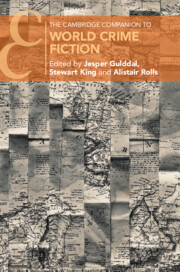Book contents
- The Cambridge Companion to World Crime Fiction
- The Cambridge Companion to World Crime Fiction
- Copyright page
- Contents
- Notes on Contributors
- Preface
- Chronology
- Chapter 1 What Is World Crime Fiction?
- Chapter 2 Crime Fiction and the International Publishing Industry
- Chapter 3 The Translation and Circulation of Crime Fiction
- Chapter 4 The International Crime Fiction Collection
- Chapter 5 Regional Crime Fiction
- Chapter 6 Women in World Crime Fiction
- Chapter 7 East Asian Crime Fiction
- Chapter 8 Crime Fiction in South Asia
- Chapter 9 Arab Crime Fiction
- Chapter 10 The Crime Fiction of Sub-Saharan Africa
- Chapter 11 European Crime Fiction
- Chapter 12 Scandinavian Crime Fiction
- Chapter 13 Iberian and Latin American Crime Fiction
- Chapter 14 World Crime Fiction in French
- Further Reading
- Index
- Cambridge Companions To …
Chapter 8 - Crime Fiction in South Asia
Published online by Cambridge University Press: 14 April 2022
- The Cambridge Companion to World Crime Fiction
- The Cambridge Companion to World Crime Fiction
- Copyright page
- Contents
- Notes on Contributors
- Preface
- Chronology
- Chapter 1 What Is World Crime Fiction?
- Chapter 2 Crime Fiction and the International Publishing Industry
- Chapter 3 The Translation and Circulation of Crime Fiction
- Chapter 4 The International Crime Fiction Collection
- Chapter 5 Regional Crime Fiction
- Chapter 6 Women in World Crime Fiction
- Chapter 7 East Asian Crime Fiction
- Chapter 8 Crime Fiction in South Asia
- Chapter 9 Arab Crime Fiction
- Chapter 10 The Crime Fiction of Sub-Saharan Africa
- Chapter 11 European Crime Fiction
- Chapter 12 Scandinavian Crime Fiction
- Chapter 13 Iberian and Latin American Crime Fiction
- Chapter 14 World Crime Fiction in French
- Further Reading
- Index
- Cambridge Companions To …
Summary
Detective or crime fiction has had a long and varied history in South Asia, at times inflected by local concerns, at other times transporting readers into a world of international intrigue. This chapter traces its development from its colonial origins under the aegis of a local boom in print media, ‘intrusive’ colonial law and policing and the influx of European narratives combined with precolonial tropes. The chapter focuses on iconic ‘homegrown’ detectives like Byomkesh Bakshi in the 1930s, the quintessential Bengali gentleman detective engaged in the high pursuit of truth, the debonair detectives Faridi and Imraan created by Indo-Pakistani writer Ibne Safi in the 1950s–1970s, and the heroes of ‘hard-boiled’ Hindi crime fiction in the 1970s–1990s. Crime fiction has also allowed women writers to imagine bold female detectives who challenge and debate gender norms, from Kamala Satthianadhan’s trailblazing Detective Janaki (1934) to Sujatha Massey’s Perveen Mistry. Crime fiction in South Asia has been intensely translational, not just from English but also across South Asian languages. It has pioneered its own distribution channels and spawned adaptations across media platforms.
- Type
- Chapter
- Information
- The Cambridge Companion to World Crime Fiction , pp. 141 - 159Publisher: Cambridge University PressPrint publication year: 2022
- 1
- Cited by



